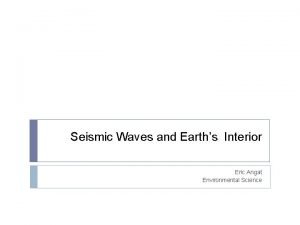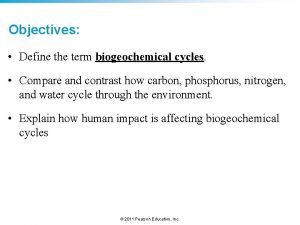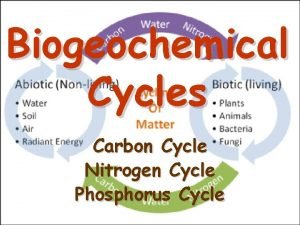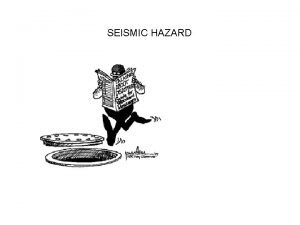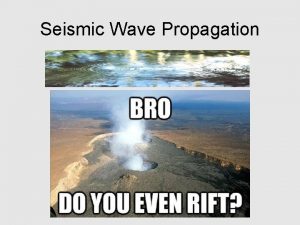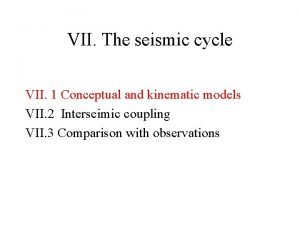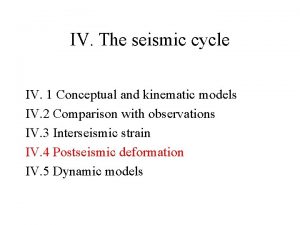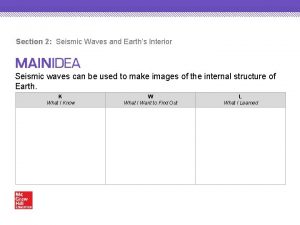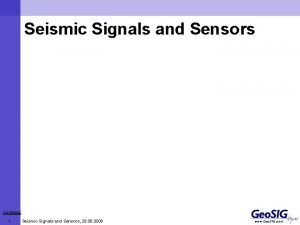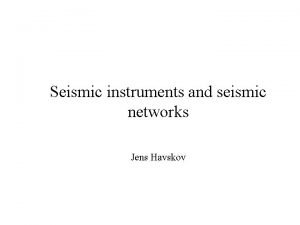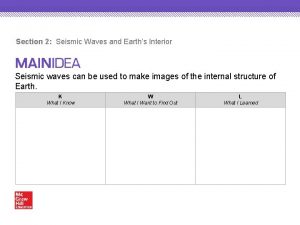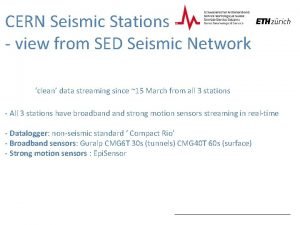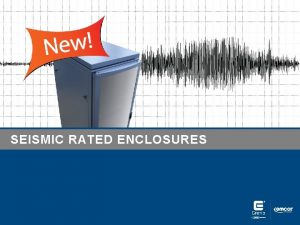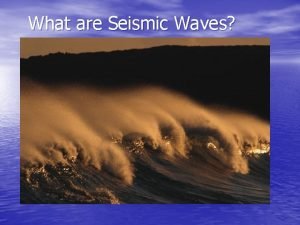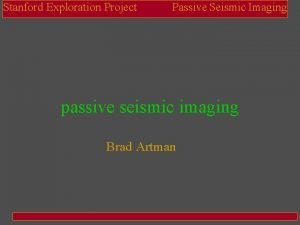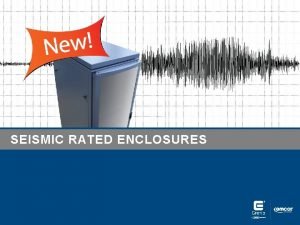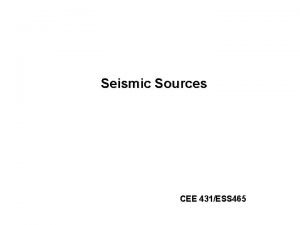IV The seismic cycle IV 1 Conceptual and













































- Slides: 45

IV. The seismic cycle IV. 1 Conceptual and kinematic models IV. 2 Comparison with observations IV. 3 Interseismic strain IV. 4 Postseismic deformation IV. 5 Dynamic models

Source Model of Nias Earthquake Source duration: 100 s, Rupture velocity: 2 -2. 5 km/s; Rise time: 15 sec (Konca et al, 2007)

Postseismic deformation over 11 months

Time evolution of postseismic slip -The spatial distribution of afterslip is approximately stationary. - Slip increases in proportion to the logarithm of time ~ (Hsu et al, 2006)

1995 Antofagasta earthquake, N. Chile (Mw = 8. 0) 1993 -95 Displacements (dominated by co-seismic) 1996 -97 Velocities (2 years after earthquake) Data from Klotz et al. (1999) and Khazaradze and Klotz (2003) (From Kelin Wang, SEIZE meeting, 2008)

Alaska: ~ 40 years after a great earthquake M = 9. 2, 1964 Freymueller et al. (2008) The plate interface has partially or completely relocked in the rupture area. Some stations on land still move seaward!

Chile: ~ 40 years after a great earthquake M = 9. 5, 1960 GPS data: Green: Klotz et al. (2001) Red: Wang et al. (2007) (From Kelin Wang, SEIZE meeting, 2008; Wang, 2007)

Cascadia: ~ 300 years after a great earthquake Wells and Simpson (2001) (From Kelin Wang, SEIZE meeting, 2008; Wang, 2007)

Rupture Lo cki ng Afterslip Stress relaxation Afterslip and transient slow slip: short-lived, fault friction Stress relaxation: long-lived, mantle rheology (From Kelin Wang, SEIZE meeting, 2008; Wang, 2007)

Coast line Inter-seismic (Cascadia) Post-seismic 2 (Alaska, Chile) Post-seismic 1 (Sumatra) Co-seismic Coast line

References Hsu, Y. J. , M. Simons, J. P. Avouac, J. Galetzka, K. Sieh, M. Chlieh, D. Natawidjaja, L. Prawirodirdjo, and Y. Bock (2006), Frictional afterslip following the 2005 Nias-Simeulue earthquake, Sumatra, Science, 312(5782), 1921 -1926. Wang, K, Elastic and Viscoelastic Models of Crustal Deformation in Subduction Earthquake Cycles, In The Seismogenic Zone of Subduction Thrust Faults, edited by T. Dixon and J. C. Moore, Columbia University Press, 2007.

IV. The seismic cycle IV. 1 Conceptual and kinematic models IV. 2 Comparison with EQ observations IV. 3 Learning from interseismic strain IV. 4 Dynamic models

• Kinematic model : the model is parametrised in term of the slip history on the fault (earthquakes, interseismic defornation, postseismic deformation…. ) • Dynamic model: Deformation, including slip history on faults is deduced from the rheology and boundary conditions.

Is this model consistent with our understanding of the mechanics of crustal deformation? What is the reason for transition to the Locked Fault one to the Creeping zone?

Crustal Rheology ‘brittle’ ‘ductile’ (Kohlstedt et al. , 1995)

In all plots solid lines are linear least squares fit to the data. Dotted lines represent fit to data of the flow-law at the bottom of each plot (Mackwell et al. , 1998)

The shear stress at frictional yield depends linearly on normal stress Static Friction is generally of the order of 0. 6 for most rock types (Byerlee, 1978)

Condition for ‘stick-slip’ sliding Stick-slip motion requires weakening during seismic sliding, hence static friction > dynamic friction (Scholz, 1990) -unstable slip is possible if the decrease of friction is more rapid than elastic unloading during slip (‘slip weakening’) - The fault needs to restrength with time afetr slip event (‘healing’).

Static friction depends on hold time Dc Dynamic friction decreases with slip rate (Marone, 1998)

Rate-and-State Friction (Scholz, 1990) t/s=m=m*(T)+a ln(V/V*)+b ln(q/q*) (Dieterich 1981; Ruina 1983) dq/dt=1 -Vq /Dc Generally a and b are of the order of ~ 10 -3 -10 -2 (e. g. , Blanpied et al, 1998; Marone, 1998)

Rate-and-State Friction (Scholz, 1990) t/s=m=m*(T)+a ln(V/V*)+b ln(q/q*) (Dieterich 1981; Ruina 1983) dq/dt=1 -Vq /Dc At steady state: qss= Dc /V mss= m*+(a-b) ln(V/V*)

Effect of temperature and normal stress on friction A, Dependence of (a - b) on temperature for granite. B, Dependence of (a - b) on pressure for granulated granite. This effect, due to lithification, should be augmented with temperature. Laboratory experiments show that stable frictional sliding is promoted at temperatures higher than about 300°C, and possibly at low temperatures.

• Rate strengthening (a-b>0) : – quartzo-feldspathic rocks : T<100 C or T>300 C – poorly cohesive fault-gouge – Some clays at low temperature (T<100 C), – serpentine (T<400 C). (Marone, 1998)

Condition for ‘stick-slip’ Stick-slip motion requires weakening during seismic sliding, hence static friction > dynamic friction - unstable slip is possible if the decrease of friction is more rapid than elastic unloading during slip (‘slip weakening’)

Condition for ‘stick-slip’ • At steady state: mss= m*+(a-b) ln(V/V*) • The system is rate-strengthening if a-b>0, only stable sliding is permitted • The system is rate-weakening if a-b<0, - stick-slip is possible if the decrease of friction is more rapid than elastic unloading during slip: F/ u>K, i. e. (ms-md) σn/Dc>K - The system undergoes stable frictional sliding (conditional stability) if F/ u<K, i. e. (ms-md) σn/Dc<K (Rice and Ruina 1983; Sholz, 1990)

Stationary State Frictional Sliding mss== t/s= m*+(a-b) ln(V/V*) (Rice and Ruina 1983) a-b < 0 a-b > 0 slip is potentially unstable sliding a-b Correspond to T~300 °C For Quartzo. Feldspathic rocks (Blanpied et al, 1991)

Seismic Cycle Modeling Tinter= 96. 2 ans Maximum sliding velocity on the fault as a function of time. Slip as a function of depth. Each line represents the slip distribution at a given time. Every 5 yr in the interseismic period. For velocity change of 10% durin dynamic rupture. (Perfettini et al, 2003)

Slip as a function of depth over the seismic cycle of a strike–slip fault, using a frictional model containing a transition from unstable to stable friction at 11 km depth (Tse and Rice, 1981; Shloz, 1992)

(Avouac, 2003) Aseismic stable frictional becomes dominant for temperatures above ~ 300°C-400°C. This is consistent with laboratory experiments which show that stable frictional sliding (a-b>0) is promoted at temperatures higher than about 300°C for Quartzo-felspathic rocks. Fluids may play a role too (cf MT results). From Blanpied et al, (1991)

Constitutive laws used to model crustal deformation and the seismic cycle Frictional sliding (rate-and-state friction) t/s=m=m*+a ln(V/V*)+b ln(q/q*) dq/dt=1 -Vq /Dc Ductile Flow dε/dt = A f. H Om σ n ℮-Q/RT 2

(Cattin and Avouac, JGR, 2000) FEM code: ADELI (Hassani, Jongmans and Chery 1997) Rheology: Brittle failure (Drucker-Prager criterion) Non linear, temperature dependent creep law Surface processes: Linear diffusion + flat deposition in the foreland Boundary conditions: Hydrostatic fundation, 20 mm/yr horizontal shortening

Mechanical model - FEM ADELI (Hassani, Jongmans and Chery 1997) - Rheology: Coulomb brittle failure + Non linear creep law depending on local temperature. - Surface processes: linear diffusion and flat deposition in the foreland - Boundary conditions: Hydrostatic fundation, 18 mm/yr horizontal shortening (Cattin and Avouac, JGR, 2000)

Due to thermally activated flow law the model predicts a localized ductile shear zone that coincides with the creeping zone of the MHT. (Cattin and Avouac, JGR, 2000)

21 +/-1. 5 mm/yr The effective friction on the MHT needs to be low (<0. 1)

Modeling Interseismic Deformation • Provided that effective friction on MHT is low (<0. 1), the model reconciles geodetic and holocene deformation • Seismicity falls in the zone of enhanced Coulomb stress in the interseismic period (Cattin and Avouac, 2000)

Modeling postseismic Deformation

Modeling postseismic Deformation

Viscoelastic stress relaxation model for Chile, viscosity 2. 5 1019 Pa s (c) (Hu et al, 2004)

Earthquake followed by locking (hu et (Hu et al, 2004)

Different along-strike rupture lengths and slip magnitudes (surface velocities 35 years after an earthquake; mantle viscosity 2. 5 x 1019 Pa s) (Hu et al, 2004)

A simple Fault Model üLocked Fault Zone üBrittle Creeping Fault Zone: üDuctile Shear Zone

A simplified springs and sliders model F a-b<0 a-b>0 Frictional sliding F: Driving Force (assumed constant) Ffr : Frictional resistance Fh: Viscous resistance to Ductile Shear F = Ffr + Fh F < Ffr No slip F > Ffr Stick-slip (Perfettini and Avouac, 2004 b)

Stress transfer during the seismic cycle Fh >> DFfr F : Driving Force (assumed constant) DFfr : Co-seismic drop of frictional resistance Fh: Viscous resistance Two characteristic times are governing the temporal evolution of deformation - Brittle creep relaxation time tr - Maxell time TM Fh DFfr (Perfettini and Avouac, 2004 b)

Interseismic displacement at AREQ relative to stable South America is landward. The persistent seaward motion of AREQ after the earthquake is due to postseismic relaxation. The modeling suggest that may be interseismic is never really stationary (Perfettini et al, 2005) Displacement at AREQ relative to stable South America before and after the Mw 8. 1, 2001, Arequipa earthquake.

References Cohen, S. C. (1999), Numerical models of crustal deformation in seismic zones, Adv. Geophys. , 41, 134231. Wang, K, Elastic and Viscoelastic Models of Crustal Deformation in Subduction Earthquake Cycles, In The Seismogenic Zone of Subduction Thrust Faults, edited by T. Dixon and J. C. Moore, Columbia University Press, 2007. Cattin, R. , and J. P. Avouac (2000), Modeling mountain building and the seismic cycle in the Himalaya of Nepal, Journal of Geophysical Research-Solid Earth, 105(B 6), 13389 -13407. Wang, K. L. , J. H. He, H. Dragert, and T. S. James (2001), Three-dimensional viscoelastic interseismic deformation model for the Cascadia subduction zone, Earth Planets and Space, 53(4), 295 -306. Hu, Y. , K. Wang, J. He, J. Klotz, and G. Khazaradze (2004), Three-dimensional viscoelastic finite element model for postseismic deformation of the great 1960 Chile earthquake, Journal of Geophysical Research-Solid Earth, 109(B 12). Perfettini, H. , and J. P. Avouac (2004), Stress transfer and strain rate variations during the seismic cycle, Journal of Geophysical Research-Solid Earth, 109(B 6).
 Hát kết hợp bộ gõ cơ thể
Hát kết hợp bộ gõ cơ thể Lp html
Lp html Bổ thể
Bổ thể Tỉ lệ cơ thể trẻ em
Tỉ lệ cơ thể trẻ em Chó sói
Chó sói Tư thế worms-breton
Tư thế worms-breton Alleluia hat len nguoi oi
Alleluia hat len nguoi oi Các môn thể thao bắt đầu bằng tiếng bóng
Các môn thể thao bắt đầu bằng tiếng bóng Thế nào là hệ số cao nhất
Thế nào là hệ số cao nhất Các châu lục và đại dương trên thế giới
Các châu lục và đại dương trên thế giới Công thức tính độ biến thiên đông lượng
Công thức tính độ biến thiên đông lượng Trời xanh đây là của chúng ta thể thơ
Trời xanh đây là của chúng ta thể thơ Mật thư tọa độ 5x5
Mật thư tọa độ 5x5 Làm thế nào để 102-1=99
Làm thế nào để 102-1=99 độ dài liên kết
độ dài liên kết Các châu lục và đại dương trên thế giới
Các châu lục và đại dương trên thế giới Thơ thất ngôn tứ tuyệt đường luật
Thơ thất ngôn tứ tuyệt đường luật Quá trình desamine hóa có thể tạo ra
Quá trình desamine hóa có thể tạo ra Một số thể thơ truyền thống
Một số thể thơ truyền thống Cái miệng nó xinh thế chỉ nói điều hay thôi
Cái miệng nó xinh thế chỉ nói điều hay thôi Vẽ hình chiếu vuông góc của vật thể sau
Vẽ hình chiếu vuông góc của vật thể sau Thế nào là sự mỏi cơ
Thế nào là sự mỏi cơ đặc điểm cơ thể của người tối cổ
đặc điểm cơ thể của người tối cổ Ví dụ giọng cùng tên
Ví dụ giọng cùng tên Vẽ hình chiếu đứng bằng cạnh của vật thể
Vẽ hình chiếu đứng bằng cạnh của vật thể Vẽ hình chiếu vuông góc của vật thể sau
Vẽ hình chiếu vuông góc của vật thể sau Thẻ vin
Thẻ vin đại từ thay thế
đại từ thay thế điện thế nghỉ
điện thế nghỉ Tư thế ngồi viết
Tư thế ngồi viết Diễn thế sinh thái là
Diễn thế sinh thái là Dạng đột biến một nhiễm là
Dạng đột biến một nhiễm là Số nguyên là gì
Số nguyên là gì Tư thế ngồi viết
Tư thế ngồi viết Lời thề hippocrates
Lời thề hippocrates Thiếu nhi thế giới liên hoan
Thiếu nhi thế giới liên hoan ưu thế lai là gì
ưu thế lai là gì Khi nào hổ mẹ dạy hổ con săn mồi
Khi nào hổ mẹ dạy hổ con săn mồi Sự nuôi và dạy con của hổ
Sự nuôi và dạy con của hổ Sơ đồ cơ thể người
Sơ đồ cơ thể người Từ ngữ thể hiện lòng nhân hậu
Từ ngữ thể hiện lòng nhân hậu Thế nào là mạng điện lắp đặt kiểu nổi
Thế nào là mạng điện lắp đặt kiểu nổi Hvac seismic cable factory
Hvac seismic cable factory Which seismic wave refracts and cannot penetrate the core
Which seismic wave refracts and cannot penetrate the core Difference between phosphorus cycle and carbon cycle
Difference between phosphorus cycle and carbon cycle Difference between phosphorus cycle and carbon cycle
Difference between phosphorus cycle and carbon cycle











































